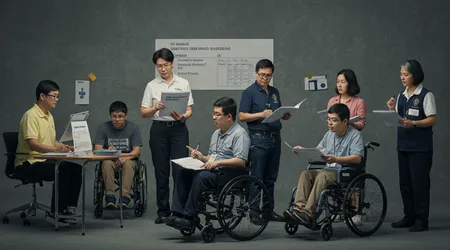How Disability Is Represented in National Census and Why It Matters

Disability is represented in national census data through carefully crafted questions, shaping policies and resources for millions.
But why does this representation matter so deeply? The census isn’t just a headcount; it’s a mirror reflecting society’s diversity, needs, and gaps.
Accurate disability data drives funding, informs legislation, and amplifies voices often sidelined. Missteps in how disability is represented in national census can distort reality, leaving communities underserved.
This article explores the mechanisms of disability data collection, its profound impact, and the stakes of getting it right in 2025.
From policy to perception, we’ll unpack why precise representation is a cornerstone of equity, weaving together real-world implications, current challenges, and actionable insights.
The Mechanics of Disability Data Collection
Census surveys, like the U.S. American Community Survey (ACS), ask about six disability types: hearing, vision, cognitive, ambulatory, self-care, and independent living difficulties.
Respondents reporting any difficulty are counted as disabled. This method aims to capture a broad spectrum of experiences.
Yet, simplicity risks oversimplification, missing nuanced disabilities like mental health conditions.
The ACS’s yes/no questions, while streamlined, can exclude those with less visible impairments. For example, someone managing depression with medication might not self-identify as disabled.
This gap affects data accuracy, skewing resource allocation. The Census Bureau refines questions to balance clarity and inclusivity, but challenges persist.
In 2023, a proposed shift to the Washington Group Short Set (WG-SS) sparked debate. It focused on severe limitations, potentially undercounting millions.
++ Prison Reform and Disability: An Overlooked Civil Rights Issue
Advocacy halted this change, preserving broader definitions. Disability is represented in national census through evolving tools, but precision remains elusive.
Consider Jane, a fictional office worker with chronic fatigue syndrome. Her condition limits daily tasks, but she hesitates to report it, fearing stigma.
If Jane’s experience is overlooked, policies may neglect her needs, perpetuating inequity. Accurate questions are vital for visibility.

Why Representation Shapes Policy
Accurate census data directly influences federal funding for disability programs. In 2021, ACS data showed 14% of Americans had disabilities, guiding billions in resources.
Disability is represented in national census to allocate funds for housing, healthcare, and education.
Underreporting can slash budgets for programs like Section 811, which supports disabled individuals’ housing.
Rural areas, where disability rates are higher, suffer most when data misses the mark. Precise counts ensure equitable resource distribution, addressing real needs.
Also read: How Inclusive Education Benefits All Students -Not Just Those with Disabilities
Advocacy groups rely on census data to push for policy changes. For instance, the National Disability Rights Network uses ACS figures to highlight underfunded services.
When disability is represented in national census accurately, it empowers evidence-based advocacy.
Imagine a small town where census data undercounts disabled residents.
Local schools lose funding for accessibility upgrades, leaving students like Tom, a wheelchair user, stranded. Robust data prevents such oversights, ensuring no one is left behind.
The Social Impact of Census Data
Beyond policy, census data shapes societal perceptions of disability.
When disability is represented in national census inclusively, it normalizes diverse experiences, reducing stigma. Inaccurate data can reinforce harmful stereotypes, marginalizing communities further.
Media often draws from census figures to frame disability narratives. Accurate data fosters stories of resilience, not pity.
For example, 2021 ACS data highlighted employment gaps, sparking discussions on workplace inclusion. Representation matters for cultural shifts.
Undercounting can erase entire groups, like those with invisible disabilities. This fuels societal invisibility, deepening isolation.
Read more: Government Subsidies for Assistive Technology: Who Really Qualifies?
Conversely, robust data validates experiences, fostering community and advocacy. Disability is represented in national census to reflect reality, not obscure it.
Take Sarah, a fictional veteran with PTSD. If census data excludes her, media might overlook veterans’ mental health, silencing her story.
Inclusive data amplifies voices, driving empathy and action in public discourse.
Challenges in Capturing Disability
Capturing disability is represented in national census faces hurdles like stigma and question design.
Many avoid self-identifying due to societal bias, especially for mental health conditions. This underreporting distorts data, undermining policy effectiveness.
The ACS’s six-question framework, while comprehensive, struggles with subjective interpretations.
For instance, “difficulty concentrating” may not resonate with someone managing autism. Refining questions to capture diverse experiences is a persistent challenge.
Proposed changes, like the 2023 WG-SS shift, risked excluding milder disabilities, potentially dropping counts by 40%.
Advocacy from groups like the National Council on Disability preserved broader metrics. Disability is represented in national census through contested, evolving methods.
Cultural factors also complicate data collection. In some communities, disability carries heavy stigma, deterring reporting.
Tailored outreach, like multilingual surveys, could improve accuracy but requires investment. Precision demands cultural sensitivity.
The Stakes of Inaccurate Data
Inaccurate data can devastate communities. If disability is represented in national census poorly, funding for programs like Medicaid or vocational training shrinks. Rural disabled populations, already underserved, face greater barriers.
For example, 2021 ACS data revealed higher disability rates in rural areas, guiding targeted healthcare investments.
Undercounting could redirect funds elsewhere, leaving rural clinics underfunded. Accuracy is a lifeline for equitable resource allocation.
Misrepresentation also skews research. Policymakers rely on census data to study employment or education gaps.
Flawed data leads to misguided policies, perpetuating systemic inequities. Disability is represented in national census to ground truth in policy.
Consider a city planner using faulty data to design public transit.
Without accurate disability counts, accessibility features like ramps may be deprioritized, stranding residents. Robust data ensures infrastructure reflects real needs.
Technology and Accessibility in Data Collection

Technology offers solutions to improve how disability is represented in national census.
Online surveys can include audio descriptions or screen-reader compatibility, aiding accessibility. Yet, digital divides pose challenges for rural or low-income disabled individuals.
In 2025, the Census Bureau is piloting AI-driven tools to analyze open-ended responses, capturing nuanced disabilities.
These innovations could enhance accuracy but require rigorous testing to avoid bias. Technology must prioritize inclusivity.
Accessibility extends to outreach. Social media campaigns can encourage participation, but they must be tailored to disabled communities.
For instance, videos with captions reach Deaf individuals, boosting response rates. Representation hinges on access.
Imagine a blind individual navigating an inaccessible survey platform. Frustration leads to non-response, skewing data.
Accessible tech ensures disability is represented in national census comprehensively, capturing diverse voices.
A Call for Inclusive Representation
Why should we settle for partial truths when counting disability? Inclusive representation in census data is non-negotiable for equity. Disability is represented in national census to reflect society’s full spectrum, not a narrow slice.
Advocates must push for questions that capture invisible disabilities, like mental health or chronic illnesses.
Engaging communities in survey design ensures relevance. The Census Bureau’s 2023 response to advocacy shows change is possible.
Individuals can act, too. Responding to surveys like the ACS ensures voices are counted.
Community leaders can promote participation, countering stigma. Every response shapes how disability is represented in national census.
Think of census data as a bridge connecting needs to solutions. If the bridge is shaky, resources don’t reach those who need them most. Strong, inclusive data builds a sturdier path forward.
Data Snapshot: Disability in the U.S.
| Category | Statistic | Source |
|---|---|---|
| Disability Prevalence | 14% of U.S. population (2021) | ACS 2021 |
| Rural Disability Rate | Higher than urban areas | U.S. News/ACS |
| Funding Impact | $Billions allocated via ACS data | Census Bureau |
This table underscores the scale of disability and its policy implications, drawn from reliable 2021 ACS data. Accurate counts drive impactful change.
Conclusion: A Mirror for Society
The way disability is represented in national census isn’t just a technical issue it’s a moral one.
It shapes who gets seen, supported, and empowered. From funding critical programs to challenging societal stigma, accurate data is a catalyst for justice.
In 2025, as the Census Bureau refines its methods, we must demand inclusivity, accessibility, and precision. Advocacy, like the 2023 push against WG-SS changes, proves our voices matter.
Let’s keep pushing for a census that mirrors reality, ensuring no one is left in the shadows. Together, we can build a future where every disability is counted, and every voice is heard.
Frequently Asked Questions
Why does disability representation in the census matter?
It ensures accurate funding and policy decisions, reducing inequities for disabled communities.
How can individuals improve census accuracy?
Participate in surveys like the ACS and encourage others, countering stigma.
What are invisible disabilities, and why are they undercounted?
Conditions like mental health issues are often unreported due to stigma or unclear survey questions.
How does technology aid census accessibility?
Tools like screen readers and AI analysis enhance participation and data nuance.
Sources:
